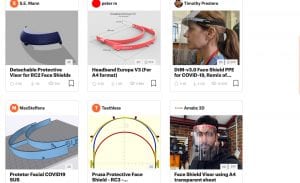
Photo courtesy of PRUSA Research. info@prusa3d.com
Many individuals and small to medium sized enterprises are looking for ways to utilize their skills and equipment to help address the shortage of PPE caused by the Covid-19 Pandemic. One of the items they are focusing on is face shields, and while intentions are good, producing these items on the fly and without expert guidance most often results in wasted time and inferior products.
To address this gap, the experts in BCIT’s MAKE+ Applied Research group have developed the Covid-19 Face Shield Design Guidance Document that provides necessary background information, functional performance, and usability requirements for the design and fabrication of face shields. The primary purpose of this whitepaper is to provide readers with pertinent information so that they can: reasonably evaluate the necessary information for a medical face shield design and or fabrication project and make an informed decision about how suitable a design is for the intended use.
To assist in determining how effective your face shield design is before you start to manufacture, experts have included a checklist in Appendix 1 at the end of Covid-19 Face Shield Design Guidance Document.
The individual and industrial response to the current Personal Protective Equipment (PPE) shortage due to the COVID-19 global pandemic has been unprecedented. Never before have small and medium sized enterprises had the ability to generate the output required to meet the increased demand brought on by any preceding circumstance. Much of this capacity has been created by the now almost universal presence of 3d printing technology in both private homes and businesses. This technology has made it possible for almost anyone to manufacture PPE such as face shields requiring only a Computer Aided Design (CAD) file and a 3d printer.
In the days following the emergence of the pandemic, many face shield designs were made available on the internet to download and manufacture. In many cases, the requirements for each design solution were not clearly articulated and, consequently, the relative performance of each design varies for the intended use.
“Once you have defined the a set of design requirements, you have a reference to evaluate whether or not your design is appropriate for its intended use. This paper was written to help anyone wishing to make medical face shields to ensure that their design is fit for purpose and will be both safe and effective.” Nigel Halsted, project leader BCIT MAKE+
To assist in determining how effective your face shield design is before you start to manufacture, experts have included a checklist in Appendix 1 at the end of Covid-19 Face Shield Design Guidance Document.
For more information please contact:
Nigel Halsted, MBA, B.Tech, Dipl. T.
Project Leader, MAKE+
BCIT Centre for Applied Research and Innovation
BCIT’s MAKE+ group of multidisciplinary research staff focuses on product and process development, evaluation, applied research projects, and education.